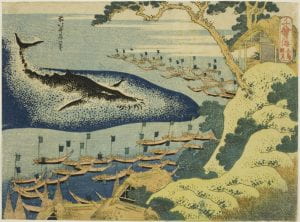Image: Hisaka Island, largest of the four nominated sites, Gotō Archipelago, 1 October 2015, Kyushu Air Lines, © Nagasaki Préfecture. https://whc.unesco.org/en/documents/166084.
What better way to gain a true understanding of a place and culture than through asking the locals?
Dr Gwyn McClelland, UNE Lecturer in Japanese Studies, has been doing just that by researching an oral history of the islands of the Gotō region off Kyushu Island in Japan.
‘I first became interested in the Gotō as I realised a number of the Catholic community I spoke with in my earlier project based in Nagasaki had ancestry in these islands’, said Dr McClelland.
The Gotō islands are a treasure trove of history with a wealth of insights into the peoples who called it home. Historically the islands are known as heavenly refuges, mountains where the people built terraces for growing potatoes and rice; and importantly for Dr McClelland’s research, hideaways for clandestine religious practices. Religious refugees arrived in the Gotō region in the 18th and 19th centuries, where they had to contend with a harsh winter climate, the strong prejudices of indigenous inhabitants, and the long arms of the Nagasaki magistrate. The magistrate enforced the regime of the Tokugawa Shogunate.
These refugees were a migrant people pursued for their religious leanings, known nowadays as the ‘Hidden Christians’, and descended of people who became Christians during the early missionary period from the 1550s to early 1600s. Hidden Christians, as the name implies, were Japanese Christians who practiced Christianity in secret due to the lack of religious freedom in the 18th and 19th centuries.
Dr McClelland’s research demonstrates that a far deeper understanding of the Hidden Christian migrants of the Gotō islands stands to be achieved through a study of the regions’ oral history. In history, whereas oral evidence has been marginalised in the past, since the 1970s there has been an increasing awareness that oral history contributes to a ‘history from below’ (Oxford Handbook of Oral History, Chapter 5).
The Hidden Christian legacy has already been recognised by a number of new UNESCO World Heritage sites, added in 2018. By analysing the history surrounding four World Heritage sites on the Gotō Archipelago in a new article, Dr McClelland found that a religious cultural hybridity, a blending of traditions, emerged in the region as early as the 18th century. Just as islands are once again made quarantine centres during the current pandemic, one of these World Heritage sites was a quarantine island.
“There were multiple traditions which had varied practices and worship traditions,” said Dr McClelland in a recently released article about his research. “The variability of the Hidden Christians in culturally hybrid Shinto and Buddhist forms and in their adaptation to the diverse environs should be more clearly highlighted. By better defining Hidden Christians in their multiple forms, we will better understand how their traditions were adaptive and drew upon memory.”
“Within the new article, I have complicated the concept of who the ‘Hidden Christians’ were and who they represent today. The legacy of the Hidden Christians is still particularly important for the modern Catholic populace, who are around 10% of the island peoples”
One of the key points Dr McClelland discovered is that Hidden Christians “found at least some form of liberation in the islands, but they also experienced imprisonment and persecution. The adaptation of the Hidden Christians to an environment which appears harsh, in a social setting even harsher, testifies to a deep knowledge and ongoing relationship with the land, the soil, and the sea.” Understanding this island culture and its environment better will contribute to a less-hierarchical understanding of Japanese history, the writing of which often tends to ignore marginal, sea-centred perspectives.
As mentioned, Dr McClelland’s research on this topic was recently published as an article within Shima Journal, a Journal in History and Cultural Studies. If you would like to find out more and read further about this research, you can find it here.
While this is a fantastic milestone for Dr McClelland, this represents only the first part of his research project, as he also secured approval to conduct field research at the Gotō Archipelago. However, as with many research ventures that involve international fieldwork, it has been delayed due to the global pandemic.
For now Dr McClelland continues to delve into the oral history of the Gotō Archipelago and its cultures because “a new oral history of the Gotō stands to offer insights for Japanese society and Asian history more broadly.”




Recent Comments